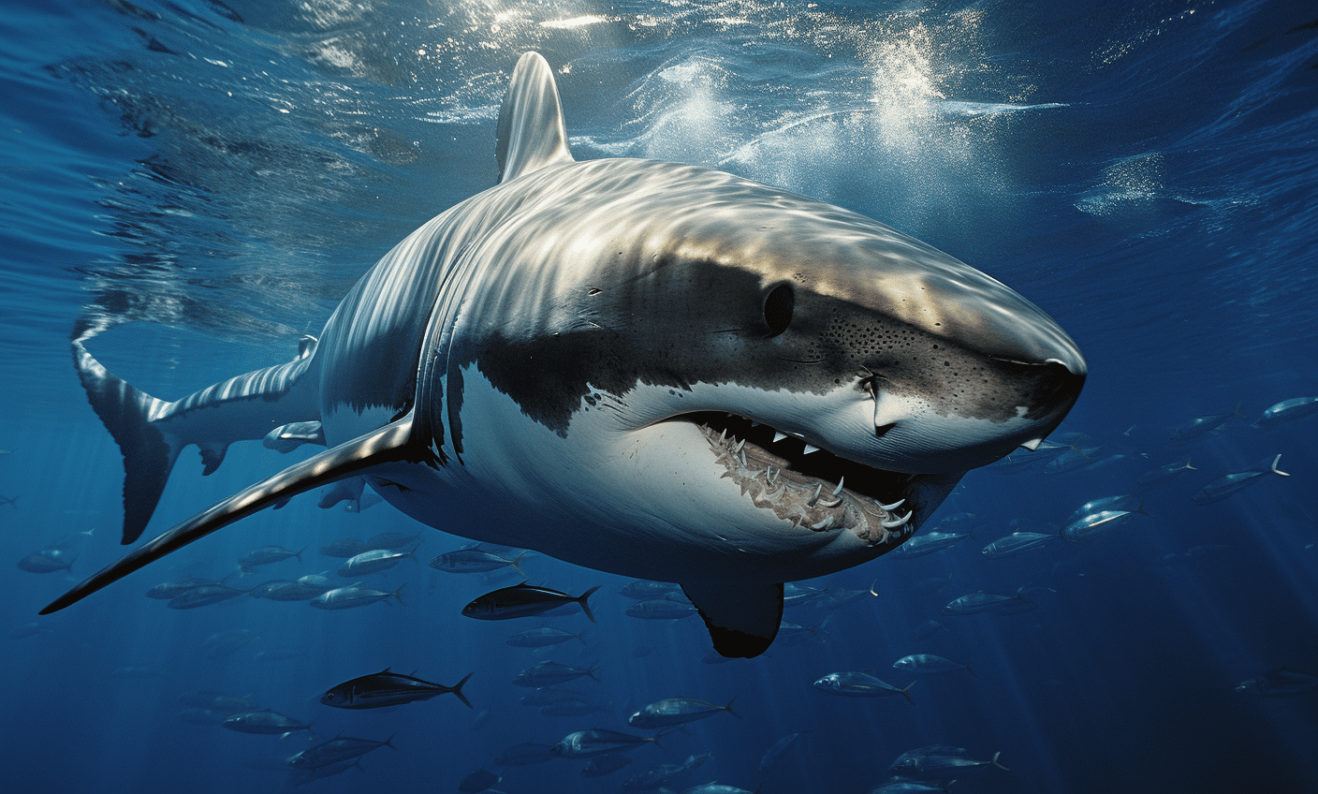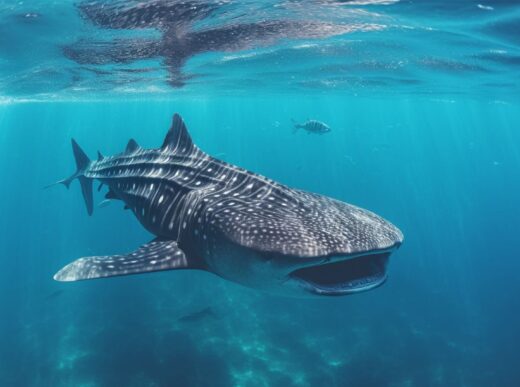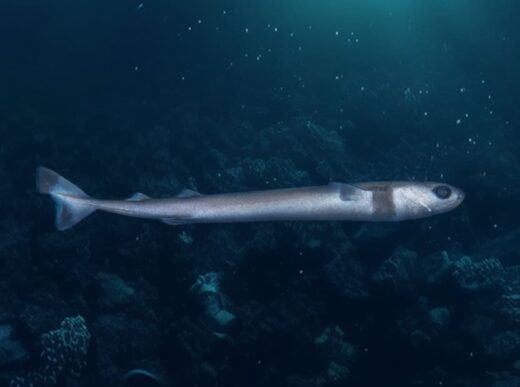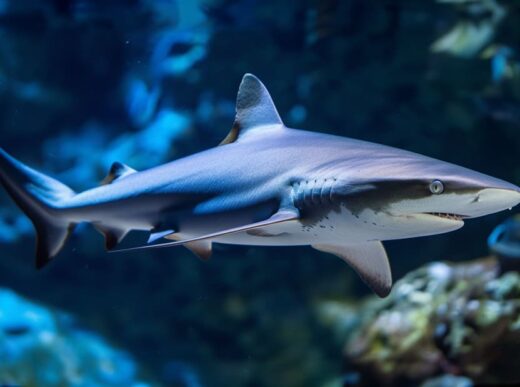Dive into the depths of the ocean with us as we unveil the intriguing world of Great White Sharks! Beyond the menacing reputation perpetuated by Hollywood’s Jaws, these marine giants have a surprising array of captivating qualities. From their global travels to the secrets of their toothy grins, we’ve rounded up 20 fun and fascinating facts that will make you see Great White Sharks in a whole new light. Join us on this underwater adventure as we unravel the mysteries of one of the ocean’s most awe-inspiring predators!
20 Amazing Facts About Great White Sharks
So get ready for an exciting journey through the mysterious waters where great white sharks reign supreme, and let’s explore the world of their amazing features.
Characteristics
1. Picture this: a Great White Shark that’s 20 feet long – that’s like a swimming school bus! But on average, they’re a bit smaller. Females, though, like to outshine the males, reaching an impressive 15–16 feet, while the guys settle at 11–13 feet.
2. Sharks are like the wise elders of the ocean, with a lifespan that can stretch up to 70 years. That’s a lot of years to perfect the art of being a shark.
3. Great Whites are like the dental enthusiasts of the sea, rocking up to 300 serrated, blade-like teeth. And here’s the kicker – they keep growing new ones throughout their lives.
4. Brace yourself for this jaw-dropping fact: the Great White Shark has the strongest bite on Earth. It can chomp down with 18,000 Newtons of force, and rumour has it, it could even take a bite out of a steel cable!
5. Sharks are all about the monochrome fashion trend. Their grey topside blends with the rocky ocean floor, while their white bellies keep them incognito from below when the sun’s shining.
6. Ever seen a shark with glowing eyes? Great Whites have a special reflective layer behind their retinas that gives them night vision. Nighttime ocean explorers, indeed!
7. Shark secret weapon: toxic fluids. Apart from sharp teeth, they’ve got corrosive gastric juice, making their digestive system a deadly force.
Habitats
8. Picture this: Great White Sharks are like the globe-trotters of the ocean. They hang out in coastal waters worldwide, with one exception—Antarctica’s a bit too chilly for their liking.
Lifestyle
9. Forget dolphin shows; Great Whites can put on a spectacular aerial display, leaping a jaw-dropping 10 feet out of the water. Talk about catching some air!
10. Great Whites are basically the bloodhounds of the ocean, detecting blood from a whopping 5 kilometres away. With their torpedo-shaped bodies, they can hit speeds of up to 57 km/h, making them the high-speed hunters of the sea.
Hunting and Feeding
11. Move over, taste buds; sharks taste with their tongues! They’ve got a cartilage tongue called basihyal that helps them decide if dinner’s up to par.
12. Great Whites are the ultimate ocean predators, feasting on everything from fish to seals, sea lions, dolphins, seabirds, sea turtles, rays, and even other sharks. They’ve got the buffet of the sea at their disposal!
Intelligence and Social Behaviour
13. Sharks have a unique dining style – they use their teeth like hands. Those movable teeth help them figure out if they’ve bitten into a tasty treat or something less appetizing.
14. Sharks are more curious than you’d think. Researchers have caught them swimming up to brightly coloured objects, taking a nibble just to see what’s up. It’s like they’re oceanic investigators.
Reproduction
15. Sharks are like the introverts of the sea, mostly going solo. They only really get together for a bit of romance, although some odd couples have been spotted traveling side by side.
16. Great White Sharks are not in a hurry to become parents. Some estimates suggest that the ladies might not even start breeding until they hit the big 3-0.
17. Shark moms have their hands (or fins) full – they give birth to 2 to 10 pups at a time, and those babies are already about six feet long when they make their debut!
18. It’s a slow dance for Great Whites when it comes to reproduction. They might take up to 22 months to bring new sharks into the world, ensuring they don’t become parents too often.
19. Survival of the fittest starts in the womb for Great White Sharks. Embryos snack on their weaker siblings and even their mom’s unfertilized eggs, ensuring only the strongest make it into the open ocean.
Danger To Humans
20. You know, that infamous Great White Shark from «Jaws»? Well, turns out they’re not as menacing as Hollywood makes them out to be. They’ve attacked humans less than 100 times in total!
Did you enjoy these fun facts about sharks? Stay with us a moment and find out the most frequently asked questions about sharks and the answers to them.
Are There Any Aquariums with Great White Shark?
The incident at Okinawa Churaumi Aquarium, where a great white shark survived only three days in captivity, underlines the challenges of keeping these apex predators in captivity. Great whites are highly migratory and have complex environmental and behavioural needs that are difficult to meet in an aquarium environment. Their short-lived survival in captivity highlights the unsuitability of artificial environments for these majestic creatures. This incident is a poignant reminder of the importance of prioritizing conservation efforts and respecting the natural behaviours and habitats of marine species such as the Great White Shark.




